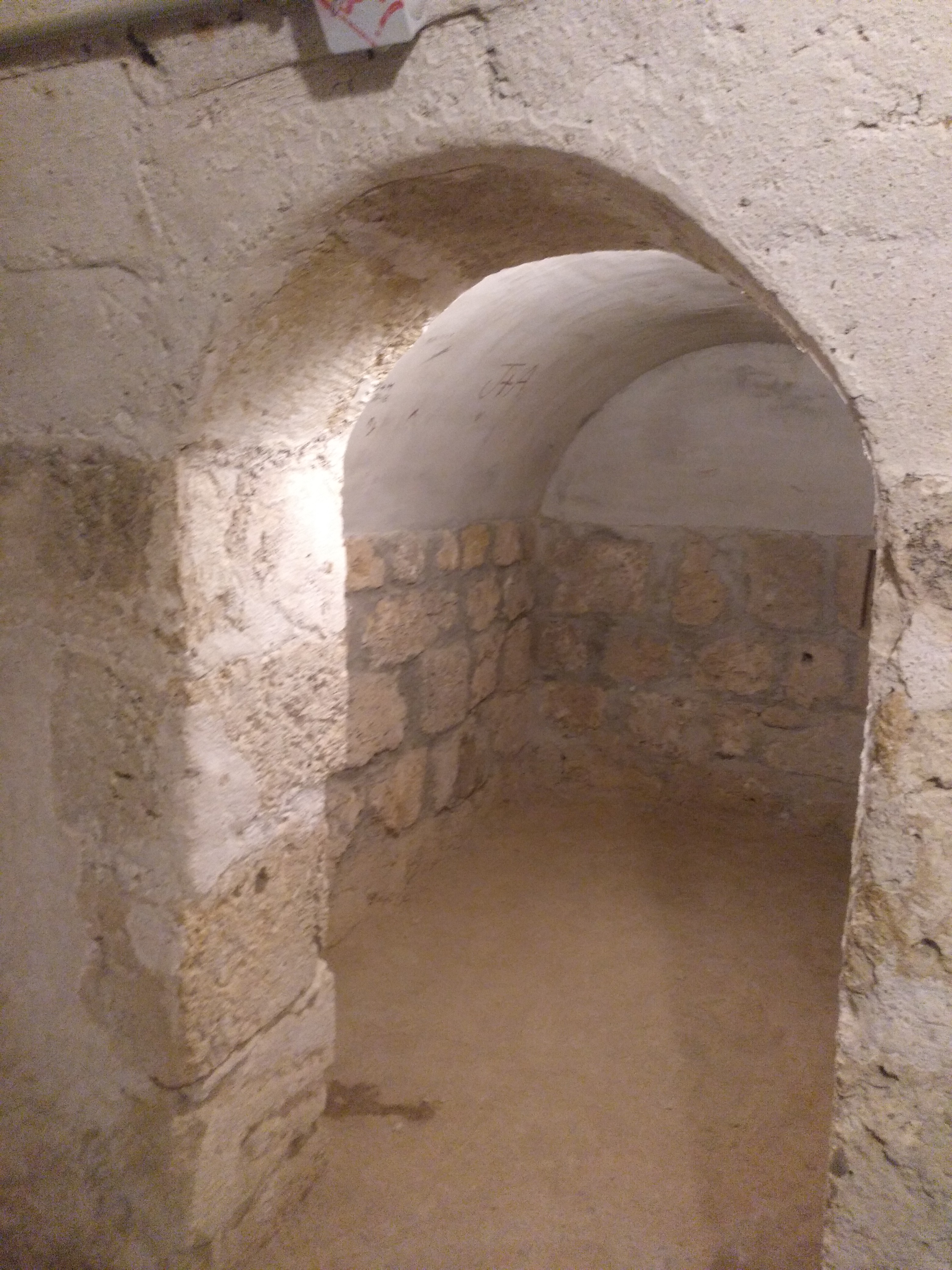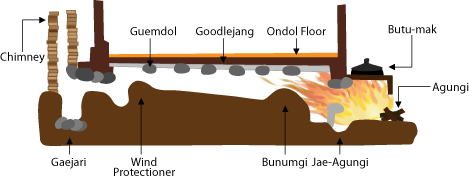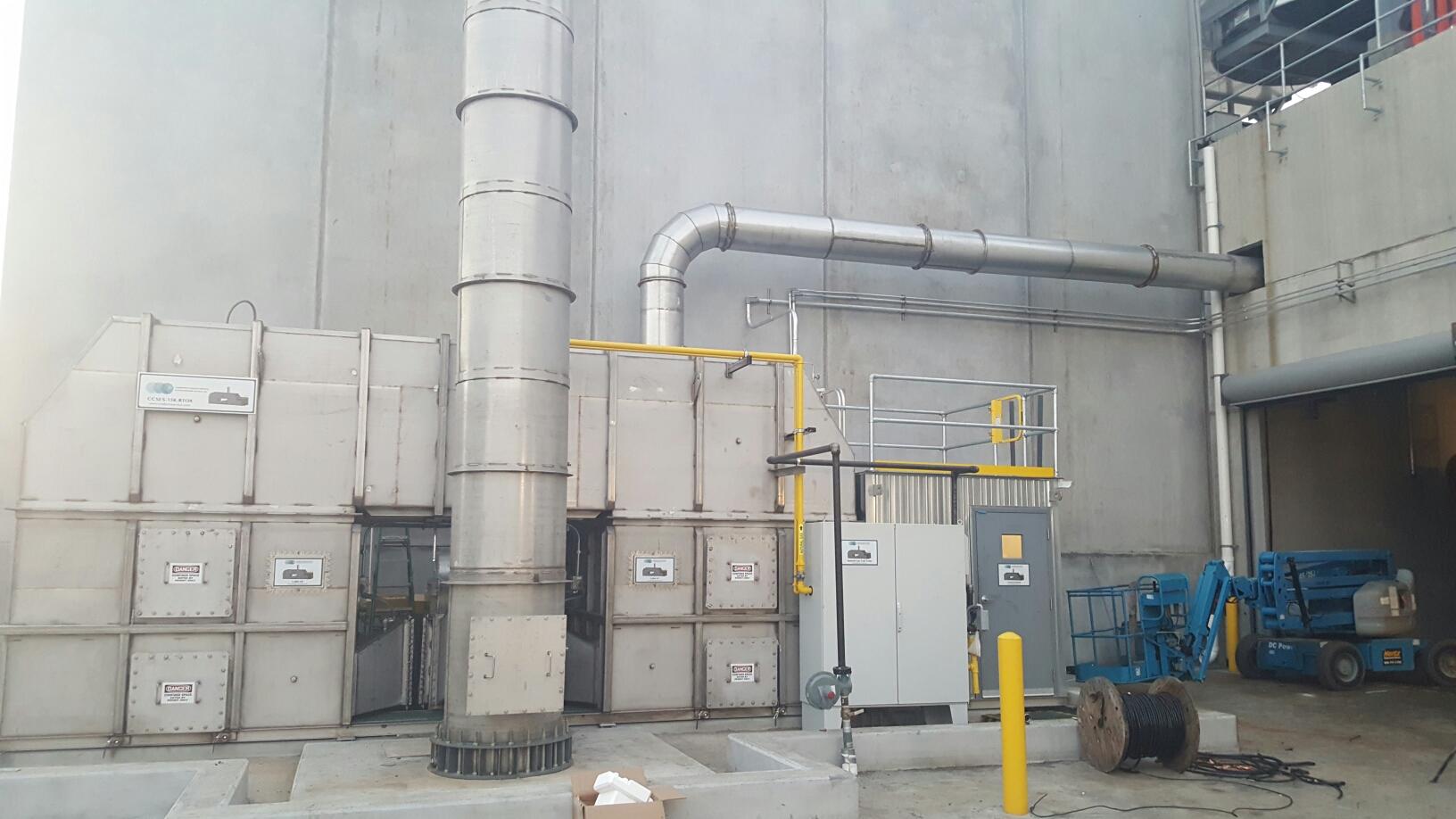|
Gloria (heating System)
Gloria (meaning ''glory'' in Spanish) is a central heating system used in Castile, beginning in the Middle Ages. It is a direct descendant of the Roman hypocaust, and its feature of regulating the rate of combustion allows people to use smaller, cheaper materials for fuel, such as leaves, hay, or twigs, instead of wood. Description The gloria consists of a firebox, generally located outside (in a courtyard, for example), which burns the fuel, and one or more ducts which run under the floors of the rooms to be heated. The warm exhaust gases from the combustion pass through these ducts and then are released outside through a vertical flue. Historically, glorias used pine needles for fuel and pine cones for kindling, in both cases using what would otherwise be waste material, saving firewood for cooking and smithing, as well as hay and silage for animal fodder. The rate of combustion (and therefore the heat output) can be regulated by restricting the airflow into the firebox. M ... [...More Info...] [...Related Items...] OR: [Wikipedia] [Google] [Baidu] |
Gloria Monasterio De Piedra 2
Gloria may refer to: Arts and entertainment Music Christian liturgy and music * Gloria in excelsis Deo, the Greater Doxology, a hymn of praise * Gloria Patri, the Lesser Doxology, a short hymn of praise ** Gloria (Handel) ** Gloria (Jenkins) ** Gloria (Poulenc), a 1959 composition by Francis Poulenc ** Gloria (Vivaldi), a musical setting of the doxology by Antonio Vivaldi Groups and labels * Gloria (Brazilian band), a post-hardcore/metalcore band * Gloria, later named Unit Gloria, a Dutch band with Robert Long as member Albums * ''Gloria'' (Disillusion album) * ''Gloria!'', an album by Gloria Estefan * ''Gloria'' (Gloria Trevi album) * ''Gloria'' (Okean Elzy album) * ''Gloria'' (Sam Smith album) * ''Gloria'' (Shadows of Knight album) (1966) * ''Gloria'' (EP), an EP by Hawk Nelson Songs * "Gloria" (Enchantment song) (1976), a song later covered by Jesse Powell in 1996 * "Gloria" (Kendrick Lamar and SZA song), 2024 * "Gloria" (Leon René song), a song releas ... [...More Info...] [...Related Items...] OR: [Wikipedia] [Google] [Baidu] |
Courtyard
A courtyard or court is a circumscribed area, often surrounded by a building or complex, that is open to the sky. Courtyards are common elements in both Western and Eastern building patterns and have been used by both ancient and contemporary architects as a typical and traditional building feature. Such spaces in inns and public buildings were often the primary meeting places for some purposes, leading to the other meanings of Court (other), court. Both of the words ''court'' and ''yard'' derive from the same root, meaning an enclosed space. See yard (land), yard and garden for the relation of this set of words. In universities courtyards are often known as quadrangle (architecture), quadrangles. Historic use Courtyards—private open spaces surrounded by walls or buildings—have been in use in residential architecture for almost as long as people have lived in constructed dwellings. The courtyard house makes its first appearance –6000 BC (calibrated), in ... [...More Info...] [...Related Items...] OR: [Wikipedia] [Google] [Baidu] |
Ondol
(; , ; ) or ''gudeul'' (; ) in Korean traditional architecture is underfloor heating that uses direct heat transfer from wood smoke to heat the underside of a thick masonry floor. In modern usage, it refers to any type of underfloor heating, or to a hotel or a sleeping room in Korean (as opposed to Western) style. The main components of the traditional ondol are an '' agungi'' (; ), a '' firebox'' or '' stove'', accessible from an adjoining room (typically kitchen or master bedroom), a raised masonry floor underlain by horizontal smoke passages, and a vertical, freestanding chimney on the opposite exterior wall providing a draft. The heated floor, supported by stone piers or baffles to distribute the smoke, is covered by stone slabs, clay and an impervious layer such as oiled paper. History Origin Use of the has been found at archaeological sites in present-day North Korea. A Neolithic Age archaeological site, ''circa'' 5000 BC, discovered in Sonbong, Rason, in present-day ... [...More Info...] [...Related Items...] OR: [Wikipedia] [Google] [Baidu] |
Hypocaust
A hypocaust () is a system of central heating in a building that produces and circulates hot air below the floor of a room, and may also warm the walls with a series of pipes through which the hot air passes. This air can warm the upper floors as well. The word derives from Ancient Greek ''hupó'' and ''kaustós'' (compare '' caustic''). The earliest reference to such a system suggests that the Temple of Ephesus in 350 BC was heated in this manner, although Vitruvius attributes its invention to Sergius Orata in c. 80 BC. Its invention improved the hygiene and living conditions of citizens, and was a forerunner of modern central heating. Roman operation Hypocausts were used for heating hot baths and other public buildings in ancient Rome. They were also used in private homes. It was considered proper and necessary by the wealthier merchant class for their villas, throughout the Roman Empire. The ruins of Roman hypocausts have been found throughout Europe (for example in It ... [...More Info...] [...Related Items...] OR: [Wikipedia] [Google] [Baidu] |
Underfloor Heating
Underfloor heating and cooling is a form of Heating, ventilation, and air conditioning, central heating and cooling that achieves indoor climate control for thermal comfort using hydronics, hydronic or electrical heating elements embedded in a floor. Heating is achieved by Conduction (heat), conduction, radiation and convection. Use of underfloor heating dates back to the Neoglacial and Neolithic periods. History Underfloor heating has a long history back into the Neoglacial and Neolithic periods. Archeological digs in Asia and the Aleutian islands of Alaska reveal how the inhabitants drafted smoke from fires through stone covered trenches which were excavated in the floors of their subterranea (geography), subterranean dwellings. The hot smoke heated the floor stones and the heat then radiated into the living spaces. These early forms have evolved into modern systems using fluid filled pipes or electrical cables and mats. Below is a chronological overview of under floor heating ... [...More Info...] [...Related Items...] OR: [Wikipedia] [Google] [Baidu] |
Castile And León
Castile and León is an Autonomous communities of Spain, autonomous community in northwestern Spain. Castile and León is the largest autonomous community in Spain by area, covering 94,222 km2. It is, however, sparsely populated, with a population density below 30/km2. While Capital of Castile and León, a capital has not been explicitly declared, the seats of the executive and legislative powers are set in Valladolid by law, and for all purposes that city (also the most populated municipality) serves as the ''de facto'' regional capital. Castile and León is a landlocked region, bordered by Portugal as well as by the Spanish autonomous communities of Galicia (Spain), Galicia, Asturias, Cantabria, the Basque Autonomous Community, Basque Country, La Rioja (Spain), La Rioja, Aragon, Castilla–La Mancha, the Community of Madrid and Extremadura. Chiefly comprising the northern half of the Meseta Central, Inner Plateau, it is surrounded by mountain barriers (the Cantabrian Mount ... [...More Info...] [...Related Items...] OR: [Wikipedia] [Google] [Baidu] |
Meseta Central
The ''Meseta Central'' (, sometimes referred to in English as Inner Plateau) is one of the basic geographical units of the Iberian Peninsula. It consists of a plateau covering a large part of the latter's interior. Developed during the 19th century, the concept of ''meseta central'' was handled by Heinrich Moritz Willkomm in lower case, and eventually was reportedly the first in using it in upper case, giving it a toponymic nature. The concept was also brought forward by José Macpherson y Hemas, while the writers of the Spanish Generation of '98 greatly contributed to its popularisation among the public sphere. The Sistema Central mountain range cuts across the Meseta Central, leaving the ''Submeseta Norte'' sub-unit (with heights mostly ranging from 700 to 800 m) to the North and the ''Submeseta Sur'' (with heights mostly ranging from 600 to 700 m) to the South. Respectively, the former is drained by the Douro The Douro (, , , ; ; ) is the largest river of the Iberi ... [...More Info...] [...Related Items...] OR: [Wikipedia] [Google] [Baidu] |
Silage
Silage is fodder made from green foliage crops which have been preserved by fermentation (food), fermentation to the point of souring. It is fed to cattle, sheep and other ruminants. The fermentation and storage process is called ''ensilage'', ''ensiling'', or ''silaging''. The exact methods vary, depending on available technology, local tradition and prevailing climate. Silage is usually made from grass crops including maize, sorghum or other cereals, using the entire green plant (not just the grain). Specific terms may be used for silage made from particular crops: ''oatlage'' for oats, ''haylage'' for alfalfa (''haylage'' may also refer to high dry matter silage made from hay). History Using the same technique as the process for making sauerkraut, green fodder was preserved for animals in parts of Germany since the start of the 19th century. This gained the attention of French agriculturist Auguste Goffart of Sologne, near Orléans. He published a book in 1877 which describ ... [...More Info...] [...Related Items...] OR: [Wikipedia] [Google] [Baidu] |
Metalsmith
A metalsmith or simply smith is a craftsperson fashioning useful items (for example, tools, kitchenware, tableware, jewelry, armor and weapons) out of various metals. Smithing is one of the oldest list of metalworking occupations, metalworking occupations. Shaping metal with a hammer (forging) is the archetypical component of smithing. Often the hammering is done while the metal is hot, having been heated in a forge. Smithing can also involve the other aspects of metalworking, such as refining metals from their ores (traditionally done by smelting), casting it into shapes (foundry, founding), and file (tool), filing to shape and size. The prevalence of metalworking in the culture of recent centuries has led ''Smith (surname), Smith'' and its equivalents in various languages to be a common surname#Occupational name, occupational surname (German Schmidt (surname), Schmidt or Schmied, Portuguese Ferreiro, Ferreira (surname), Ferreira, French Lefèvre, Spanish Herrero, Italian Fabbri ... [...More Info...] [...Related Items...] OR: [Wikipedia] [Google] [Baidu] |
Conifer Cone
A conifer cone, or in formal botanical usage a strobilus, : strobili, is a seed-bearing organ on gymnosperm plants, especially in conifers and cycads. They are usually woody and variously conic, cylindrical, ovoid, to globular, and have scales and bracts arranged around a central axis, but can be fleshy and berry-like. The cone of Pinophyta (conifer clade) contains the reproductive structures. The woody cone is the female cone, which produces seeds. The male cone, which produces pollen, is usually ephemeral and much less conspicuous even at full maturity. The name "cone" derives from Greek ''konos'' (pine cone), which also gave name to the geometric cone. The individual plates of a cone are known as ''scales''. In conifers where the cone develops over more than one year (such as pines), the first year's growth of a seed scale on the cone, showing up as a protuberance at the end of the two-year-old scale, is called an ''umbo'', while the second year's growth is called th ... [...More Info...] [...Related Items...] OR: [Wikipedia] [Google] [Baidu] |
Conifer
Conifers () are a group of conifer cone, cone-bearing Spermatophyte, seed plants, a subset of gymnosperms. Scientifically, they make up the phylum, division Pinophyta (), also known as Coniferophyta () or Coniferae. The division contains a single extant class (biology), class, Pinopsida. All Neontology, extant conifers are perennial plant, perennial woody plants with secondary growth. The majority are trees, though a few are shrubs. Examples include Cedrus, cedars, Pseudotsuga, Douglas-firs, Cupressaceae, cypresses, firs, junipers, Agathis, kauri, larches, pines, Tsuga, hemlocks, Sequoioideae, redwoods, spruces, and Taxaceae, yews.Campbell, Reece, "Phylum Coniferophyta". ''Biology''. 7th ed. 2005. Print. p. 595. As of 2002, Pinophyta contained seven families, 60 to 65 genera, and more than 600 living species. Although the total number of species is relatively small, conifers are ecology, ecologically important. They are the dominant plants over large areas of land, most notably ... [...More Info...] [...Related Items...] OR: [Wikipedia] [Google] [Baidu] |
Duct (flow)
Ducts are conduits or passages used in heating, ventilation, and air conditioning (HVAC) to deliver and remove air. The needed airflows include, for example, ''supply air'', ''return air'', and ''exhaust air''. Ducts commonly also deliver '' ventilation air'' as part of the supply air. As such, air ducts are one method of ensuring acceptable indoor air quality as well as thermal comfort. A duct system is also called ''ductwork''. Planning (laying out), sizing, optimizing, detailing, and finding the pressure losses through a duct system is called ''duct design''. Materials Ducts can be made out of the following materials: They are Galvanized steel Galvanized mild steel is the standard and most common material used in fabricating ductwork because the zinc coating of this metal prevents rusting and avoids cost of painting. For insulation purposes, metal ducts are typically lined with faced fiberglass blankets (duct liner) or wrapped externally with fiberglass blankets (duct wr ... [...More Info...] [...Related Items...] OR: [Wikipedia] [Google] [Baidu] |








